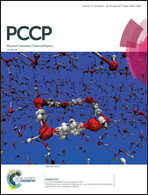4d and 5d bimetal doped tubular silicon clusters Si12M2 with M = Nb, Ta, Mo and W: a bimetallic configuration model†
Abstract
Geometries and electronic properties related to the ground state stabilities of several Si12M2 clusters (M: second-row (Nb and Mo) and third-row (Ta and W) transition metals, and their mixed bimetallic clusters M2: NbMo and TaW) were explored using density functional theory (DFT) computations. The computed results show that two different structural motifs emerge as the global energy minima of such clusters. They are basically singlet tubular structures in either a C2v prism (1A1) or a C6v antiprism (1A1) form. Other structural shapes are also possible for higher-energy isomers and in higher spin states. 58-valence electron systems including Nb2Si12, Ta2Si12, Mo2Si122+, W2Si122+, NbMoSi12+ and TaWSi12+ are thermodynamically stable as C2v prism global minima on the corresponding potential energy surfaces. Clusters containing 60 valence electrons include Mo2Si12, W2Si12, Nb2Si122−, Ta2Si122−, NbMoSi12− and TaWSi12− and they prefer a C6v anti-prism form. In the mixed MoNbSi12 and TaWSi12 open-shell systems, both resulting C2 (2A) and C2v (2A1) forms are nearly degenerate. The formation of Si12M2 clusters in such specific ground state symmetry is explained using the Jellium model and orbital interaction analyses. The investigations lead further to a proposal for a simple model of a bimetallic configuration using the nature of interactions of the transition metal d–d dimeric bond with the Si12 host, to interpret the formation of such M2Si12 clusters.



 Please wait while we load your content...
Please wait while we load your content...